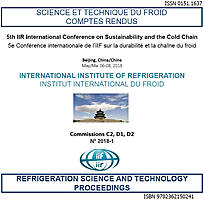
IIR document
Experimental investigation of chilling tank for atlantic salmon.
Number: pap.43
Author(s) : WIDELL K. N., NORDTVEDT T. S., TOLSTOREBROV I., et al.
Summary
Farmed salmon is a large export product from Norway. After the salmon is stunned and killed, it istransported to large tanks for bleeding, chilling and buffering before gutting and further processing. The temperature of the fish into the processing plant is varying, but it is necessary to cool down the fish fast, both to reduce bacterial growth and to maximize yield. In this paper, the chilling process in salmon specimens are investigated. The temperatures in both salmon and cooling water (RSW) were measured. All the fish was chilled by 1.0 to 3.2 °C during the stay in the tank. There are several possible reasons for the temperature variations. For examples varied the fish temperature into the tank from one test to another, the flow through the processing system varied (mainly because of technical issues in other parts) and the refrigeration system could not always provide RSW at the required temperatures. The main goal is to have more even and larger temperature differences, and to achieve that the focus should first be on the RSW system (both refrigeration system and the water pipes and components) and to ensure that it works properly.
Available documents
Format PDF
Pages: 9
Available
Public price
20 €
Member price*
Free
* Best rate depending on membership category (see the detailed benefits of individual and corporate memberships).
Details
- Original title: Experimental investigation of chilling tank for atlantic salmon.
- Record ID : 30023397
- Languages: English
- Source: 5th IIR International Conference on Sustainability and the Cold Chain. Proceedings: Beijing, Chine, 6-8 avril 2018
- Publication date: 2018/04/06
- DOI: http://dx.doi.org/10.18462/iir.iccc.2018.0043
Links
See other articles from the proceedings (72)
See the conference proceedings
Indexing
-
Themes:
Chilling of foodstuffs;
Fish and fish product - Keywords: Food industry; Temperature; Tank; Cooling; Salmon; Norway; Expérimentation
-
Challenges of effective chilling of Atlantic sa...
- Author(s) : TOLSTOREBROV I., WIDELL K. N., NORDTVEDT T. S., et al.
- Date : 2019/08/24
- Languages : English
- Source: Proceedings of the 25th IIR International Congress of Refrigeration: Montréal , Canada, August 24-30, 2019.
- Formats : PDF
View record
-
Chilling of pelagic fish onboard Norwegian fish...
- Author(s) : NORDTVEDT T. S., WIDELL K. N.
- Date : 2019/08/24
- Languages : English
- Source: Proceedings of the 25th IIR International Congress of Refrigeration: Montréal , Canada, August 24-30, 2019.
- Formats : PDF
View record
-
Chilled and frozen Atlantic salmon: Environment...
- Author(s) : REDO M. A., CHE M., WATANABE M., TOLSTOREBROV I.
- Date : 2024/06/11
- Languages : English
- Source: 8th IIR International Conference on Sustainability and the Cold Chain. Proceedings: June 9-11 2024
- Formats : PDF
View record
-
Study of convective heat transfer and chilling ...
- Author(s) : TOLSTOREBROV I., EIKEVIK T. M., WIDELL K. N., et al.
- Date : 2019/08/24
- Languages : English
- Source: Proceedings of the 25th IIR International Congress of Refrigeration: Montréal , Canada, August 24-30, 2019.
- Formats : PDF
View record
-
Sub-chilling of head-on gutted Atlantic salmon ...
- Author(s) : ROTABAKK B. T., VANGEN E., LERFALL J.
- Date : 2024/06/11
- Languages : English
- Source: 8th IIR International Conference on Sustainability and the Cold Chain. Proceedings: June 9-11 2024
- Formats : PDF
View record
